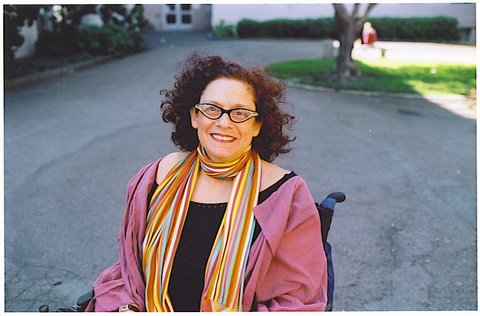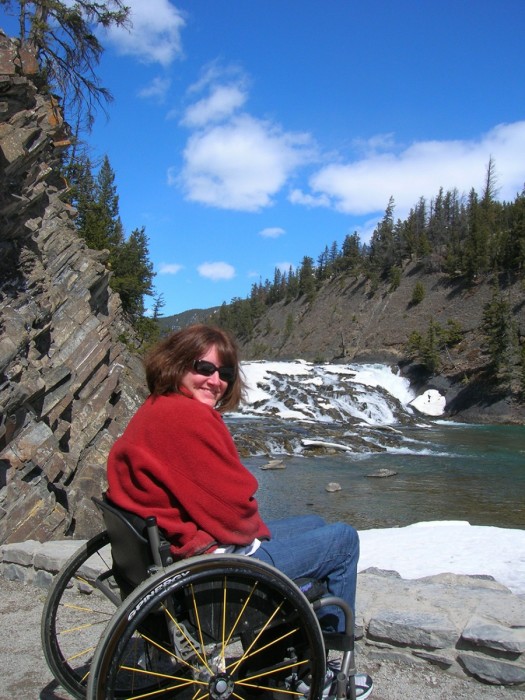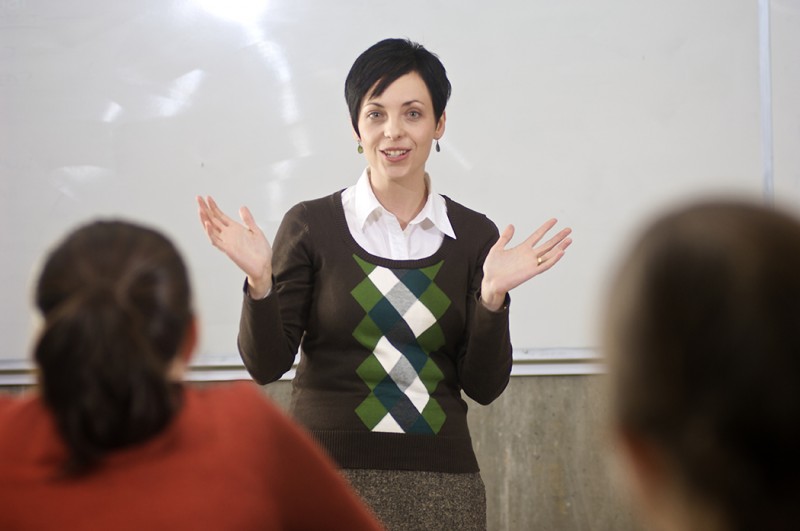
American activist, writer, performer and filmmaker Simi Linton is known as the 'mother of disability studies.'
An invitation to dance: Disability studies events highlight interdisciplinary possibilities
Last week, Simi Linton invited an audience and fellow speakers at the U of M to dance. The invitation was both figurative and literal: Linton is an American disability activist, writer, filmmaker, performer and disabled dancer on a “quest for equality, justice and a place on the dance floor” — while advocating for accessibility in academic (and other) environments and a comprehensive incorporation of a “disability lens” across the academic curriculum.
A trio of related events on Wednesday and Thursday featured U of M academics along with Linton and fellow filmmaker Christian von Tippelskirch for presentations, discussions and a screening of their documentary film, Invitation to Dance. The events were sponsored by the disability studies master’s program, Faculty of Graduate Studies, the department of English, film, and theatre in the Faculty of Arts, and the U of M’s Institute for the Humanities.
‘Impairment is inevitable’
Linton’s 1998 book Claiming Disability: Knowledge and Identity has been instrumental in changing how disability is understood — she is considered the “mother of disability studies,” says U of M PhD in English, film and theatre Nadine LeGier, who also spoke at the opening event, “Accessibility, Disability and the Humanities.”
LeGier, a scholar who uses a wheelchair and lives with MS, spoke about the ways “disability has exceeded the boundaries of medical and rehabilitative discourse.” She recently defended her dissertation, which focuses on letter-writing by several hearing-impaired or deaf Victorian authors. Part of LeGier’s work was to cast light on their community-building activities and experiences in order to dispel the myth of the successful disabled person as, in critic David T. Mitchell’s words, “a solitary overcomer.”
On the contrary, says LeGier. “Disability is a major part of the life experience of pretty much everyone. Impairment is inevitable. As humans, as we grow older, as we age … there’s some amount of impairment that we have to learn to live with.”
However, “we seem to exclude it in conversations — even though it’s such a big part of the human experience,” as she notes.
In fact, disability is more of a community-based life experience, she says. Throughout history, however, others have too often spoken for the disabled.
With this in mind, LeGier looked at letters in her dissertation — “these were people speaking about their disability themselves,” as she puts it.
“Doctors speaking about [Victorian author and social reformer] Harriet Martineau’s deafness doesn’t come into it, because it’s Harriet Martineau speaking about Harriet Martineau. And that leads one to think about the phrase used — more in the U.S. than in Canada — ‘Nothing about us without us.’”
Accessibility on campus and disability studies
Similarly for Linton, the relationship between disability and community is key.
Disability studies looks at disability issues from a social citizenship and human rights perspective, as opposed to the more common, medicalized one, says Nancy Hansen, director of disability studies at the U of M and one of the organizers of the lecture series.
Disability studies have existed in North America since the late 70s or early 80s, and the U of M’s program has operated since its first intake of students in 2003. Hansen, who was hired in August of that year, says the U of M program is unique in North America as an interdisciplinary master’s program (students graduate with an MA or M.Sc.). She also notes that Manitoba is a sort of birthplace of the rights movement in Canada, because of the members of disability community who were integral to both the process of getting disability included in the Charter of Rights and Freedoms, as well as the United Nations Convention on the Rights of People with Disabilities.
Being interdisciplinary means that disability studies includes topics such as social policy, disability history, women’s issues, research methods, disability and the media, introduction to disability studies, and disability and the environment, she says.
According to Hansen, the events last week were “a great opportunity to work with the humanities network on campus here at U of M and bring the richness of both our disciplines together and present unique and shared elements. There’s an intersectionality with disability studies and the humanities and culture that most people at first instance wouldn’t realize was there.”
The only negative thing, she adds wryly, were the lack of accessible washrooms in the Tier Building. “Washroom access is still a major problem on campus. There are accessible washrooms but they are not well-marked and you need to know where they are — there’s one on the fifth floor and the second. We happened to be on the third.”
‘A really good day for interdisciplinarity’
Vanessa Warne, an associate professor in the department of English, film, and theatre who specializes in Victorian literature with an interest in disability, also participated in the activities.
In addition her research and teaching in the area, she is working with Archives & Special Collections, U of M Libraries, on an upcoming exhibit of books for the blind produced in the 19th century, some of them in Braille and others in a now-obsolete script systems, as she explains. The exhibit, scheduled to open in November, is “really a history of book making and printing, and of this first generation of books that were created for blind readers and by blind readers,” she says.
The intersection between disability studies and the humanities is a productive one, Warne notes.
“One of the great things about Simi [Linton’s] work and [that of] disability scholars over the past two decades is that they’ve really tried to pull the study of disability into the realm of humanities research,” she says.
Warne: ‘If there would be one thing to get across, it would be that disability is an idea, disability is a set of images.’
“What they are trying to do — and what I’m hoping to participate in — is [to impart] that disability has to do with certain facts perhaps about bodies and bodily experiences — but disability has even more to do with ideas and representations and what we think and imagine and portray. If there would be one thing to get across, it would be that disability is an idea, disability is a set of images. And scholars in the humanities work on ideas and images. We’re trying to get away from what’s referred to as the medical model of disability, which sees disability as a problem and something in need of cure or rehabilitation or eradication. Whereas a humanities approach helps us to see a disability as a cultural construction, as something that is invented in many ways, as something that has a malleability and has a set of possibilities attached to it that don’t need cure, that don’t need rehabilitation. So, coming at something from a humanities perspective can make new things possible.”
New things are already becoming possible, says LeGier. “As a group today in this mini-conference, we talked about how things are changing. [As Simi mentioned, now] when you see a posting for a [humanities] job such as an English department … it will often include ‘an understanding or work in disabilities studies would be an asset’ — disabilities studies is being seen more as a useful and important discipline within the academy. More people are seeing how it is productive to engage in a conversation that [considers] disability … in text or film.”
According to Hansen, “Simi herself says that there were only three disciplines that she didn’t think that you could really introduce disability into — mathematics, physics and chemistry. And that was only because she was not well-versed in mathematics, physics and chemistry.
“Every discipline could benefit from a disability lens and it’s really important that all disciplines incorporate disability issues just as they do, say, issues around racialization, gender, ethnicity, sexuality. Disability should be on that same spectrum,” she says.
“It was a really good presentation,” she sums up. “Christian and Simi were amazing as always, and so were Nadine and Vanessa. There were both disabled and nondisabled students there and faculty from across all the disciplines. It was a really good day for interdisciplinarity.”
Making disability ordinary
The cross-conversations are a start. Too many perceptions about disability have been built on myth and misconception, asserts Hansen.
“It’s perceived as individualized tragedy — and just very negative,” she explains.
Hansen: ‘a richness in disability and what disabled people can bring to culture at large’
“But there’s a richness in disability and what disabled people can bring to culture at large — our presence enriches what’s already here. Simi used the phrase, she wants to make disability ordinary. So that it’s not exceptional — so it just is. Everybody gets to be together in a natural kind of way without this sort of limited expectation that surrounds a lot of disability today. I was listening to someone the other day who said, ‘The bar is set so low that if I get out of bed in the morning and remember my own name, it’s already considered, you know, quite exciting.’
“I’m being somewhat facetious,” she says, “but disabled people bring a lot to society as a whole. We’re contributors in a lot of different ways, artistic expression being one of them. And for disabled people, having a cultural avenue, it increases self-esteem. It makes people feel fantastic — it gives people a point of expression and positivity and it’s liberating, if you will.”
Disability studies, she says “is a great way of looking at what disability is — and more importantly at what it isn’t. Even people who’ve just started in January have said things to me like, ‘I’ll never look at disability the same way again.’ That’s kind of exciting!
“We also look at space, place and time — and how space is organized. No matter what kind of disability you have, [these] are always factors — everyone has 24 hours in a day, right? Yet for those of us who perceive and move through the world differently, it takes a lot of creativity to move around in an environment that sort of never expects you to show up. It’s sort of a surprise when you arrive.
“I don’t know where we’re ‘supposed’ to be, but it’s a surprise when we arrive,” she laughs.









